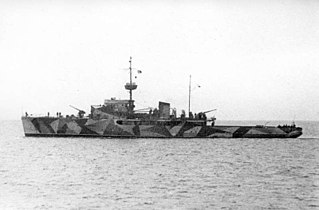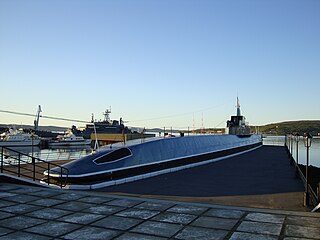
German submarine U-625 was a Type VIIC U-boat of Nazi Germany's Kriegsmarine during World War II. The submarine was laid down on 28 July 1941 at the Blohm & Voss yard in Hamburg, launched on 15 April 1942, and commissioned on 4 June 1942 under the command of Oberleutnant zur See Hans Benker.

The American Holland-class submarines, also AG class or A class, were Holland 602 type submarines used by the Imperial Russian and Soviet Navies in the early 20th century. The small submarines participated in the World War I Baltic Sea and Black Sea theatres and a handful of them also saw action during World War II.
German submarine U-214, was a Type VIID mine-laying U-boat of Nazi Germany's Kriegsmarine during World War II.

SM UB-46 was a Type UB II submarine or U-boat for the German Imperial Navy during World War I. UB-46 operated in the Mediterranean and the Black Seas, and was sunk by a mine in December 1916.
The Black Sea Campaigns were the operations of the Axis and Soviet naval forces in the Black Sea and its coastal regions during World War II between 1941 and 1944, including in support of the land forces.

German submarine U-84 was a Type VIIB U-boat of Nazi Germany's Kriegsmarine during World War II.

SM UB-45 was a Type UB II submarine or U-boat built for and operated by the German Imperial Navy during World War I. UB-45 operated in the Mediterranean and the Black Seas, and was sunk by a mine in November 1916.

HMS Pandora was a British Parthian-class submarine commissioned in 1930 and lost in 1942 during the Second World War. This class was the first to be fitted with Mark VIII torpedoes. On 4 July 1940 she torpedoed and sank the French aviso Rigault de Genouilly off the Algerian coast. In an extension of the Lend-Lease program, Pandora, along with three other British and French submarines, was overhauled at Portsmouth Naval Shipyard in the United States. She was sunk on 1 April 1942 by Junkers Ju 87 aircraft from Sturzkampfgeschwader 3 at the Valletta dockyard, Malta.
German submarine U-410 was a Type VIIC U-boat built for Nazi Germany's Kriegsmarine during World War II, operating mainly in the Mediterranean. Her insignia was a sword & shield, she did not suffer any casualties until she was sunk.

German submarine U-513 was a type IXC U-boat built for service in Nazi Germany's Kriegsmarine during World War II.
German submarine U-442 was a Type VIIC U-boat of Nazi Germany's Kriegsmarine during World War II.
German submarine U-952 was a Type VIIC U-boat built for Nazi Germany's Kriegsmarine for service during World War II. She was laid down on 1 February 1942 by Blohm & Voss, Hamburg as yard number 152, launched on 14 October 1942 and commissioned on 10 December 1942 under Oberleutnant zur See Oskar Curio.
German submarine U-436 was a Type VIIC U-boat of Nazi Germany's Kriegsmarine during World War II.

S-56 was a Stalinets-class submarine of the Soviet Navy. She was laid down by shipyard #194 in Leningrad on 24 November 1936, shipped in sections by rail to Vladivostok where it was reassembled by Dalzavod. She was launched on 25 December 1939 and commissioned on 20 October 1941 in the Pacific Fleet. During World War II, the submarine was under the command of Captain Grigori Shchedrin and was moved from the Pacific Fleet to the Northern fleet across the Pacific and Atlantic Oceans via the Panama Canal. After decommissioning, the submarine was turned into a museum ship.

NMS Amiral Murgescu was a minelayer and convoy escort of the Romanian Navy, the first sea-going warship built in Romania and the largest Romanian-built warship of World War II. She laid numerous minefields, from the Bulgarian port of Burgas to the Crimean port of Sevastopol, which inflicted significant losses to the Soviet Black Sea Fleet. She also carried out numerous convoy escort missions and took part in the Axis evacuation of the Crimea in May 1944. Due to her success in combat, she was decorated twice by May 1944. She was captured by the Soviet Union in September 1944 and served until 1988, when she was scrapped.
The Romanian Navy during World War II was the main Axis naval force in the Black Sea campaigns and fought against the Soviet Union's Black Sea Fleet from 1941 to 1944. Operations consisted mainly of mine warfare, but there were also escort missions and localized naval engagements. The largest naval action fought by the Romanian Navy was the 26 June 1941 Raid on Constanța, and its most extensive operation was the 1944 evacuation of the Crimea.
Submarine warfare in the Black Sea in World War II during 1942 involved engagements between primarily submarines of the Soviet Black Sea Fleet attacking Axis merchantmen defended by Romanian and German naval warships. These engagements were a part of the Black Sea campaigns between Axis and Soviet naval forces.

Submarine warfare in the Black Sea in World War II during 1944 involved engagements between submarines of the Soviet Black Sea Fleet attacking Axis merchantmen, defended by Romanian and German naval warships, as well as German U-boats and Romanian submarines attacking Soviet merchants on the eastern Black Sea. Before the conclusion of the campaign, Romania joined the Allies after King Michael's Coup. These engagements were a part of the naval Black Sea campaigns.

The Soviet submarine Baltic Sea campaign in 1941 was launched by the Soviet Navy at the early stage of Operation Barbarossa. The offensive was hampered by the quick German ground advance and the retreat of Soviet naval vessels from the main Baltic harbors.












